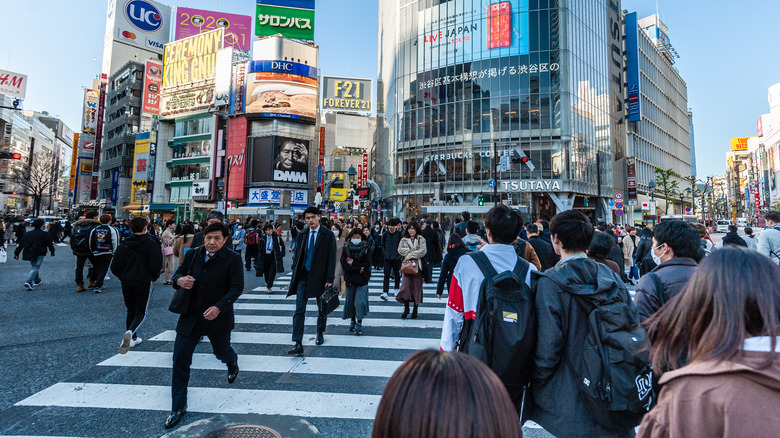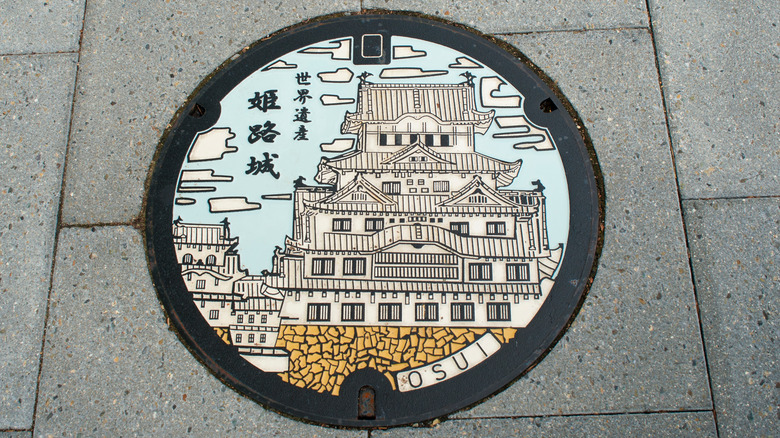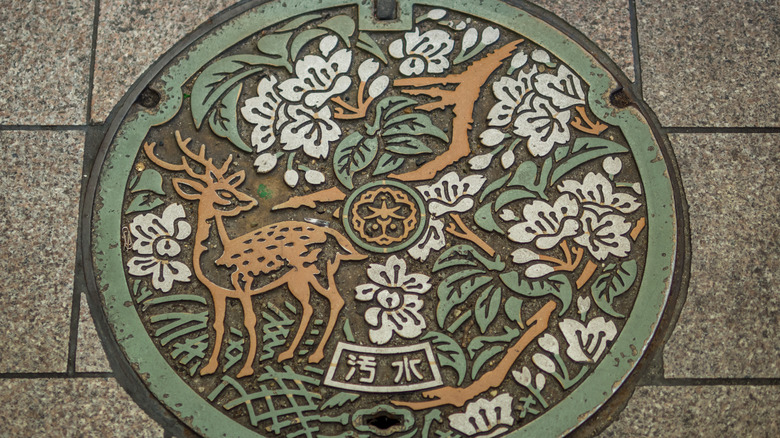Why Tourists Should Look To The Ground While Walking Around In A Japanese City
Leave it to Japan and its detail-oriented culture to transform something associated with the lowest and dirtiest of places into a work of high art. In this country, even the design of manhole covers has become a thriving art form, one that inspires "drain spotters" or "manholers" to go searching for special sewer entrances on city streets. While you're sightseeing here, remember to check the ground, as you may be stepping right over one of these decorative manhole (aka maintenance hole) covers. They're almost the perfect bookend to a sanitation process that begins with high-tech toilets.
Japan is well-known for its one-of-a-kind toilets, so much so that you can even take a two-to-three-hour Tokyo Toilet Shuttle Tour to see them around the capital. Some tourists have been inspired by the movie, "Perfect Days," which received an Oscar nomination in 2024 for its story about a Tokyo toilet cleaner, played by Koji Yakusho. When late-night TV talk show host Conan O'Brien visited Tokyo, he also forewent museums for the Toto Toilet Showroom.
You may have heard about the wonders of washlets or electronic bidet toilets with many elaborate functions in Japan. Or you may have been warned about old-fashioned Japanese toilets, which require you to squat rather than sit, since there's no real seat or lid, just a bowl built into the ground. With as much press as the aesthetics of Japan's toilets receive, it should come as no surprise that they're flushed into sewers topped with Instagrammable maintenance covers.
Keep your eyes peeled for designer maintenance covers
Above, you can see a sewer lid with a detailed rendering of the White Heron Castle in the city of Himeji. Note the word "osui," which just means "sewage" in Japanese. Himeji is one of the best spots to view gorgeous cherry blossoms in Japan, but the flowers only bloom for about two weeks. What makes drain spotting such an interesting, offbeat sightseeing alternative year-round is that it can sometimes reveal hidden treasures on otherwise nondescript streets and sidewalks.
The beautification of Japanese maintenance covers reportedly began in the 1970s and 1980s as cities sought support for tax-funded sanitation improvements. Today, many cities have maintenance covers scattered about with depictions of local landmarks or mascots. Not every cover boasts a colorful pattern; some may be plain cast iron or without any design. However, in Osaka, which has twice hosted the world expo, you could stumble across one showing the mascot for Expo 2025, for instance.
Off-season, in the sumo neighborhood of Ryogoku, Tokyo, you might be surprised to see a maintenance cover reproducing the ukiyo-e artist Hokusai's famous print, "The Great Wave," aka "Under the Wave off Kanagawa." The Sumida Hokusai Museum is nearby, hence the use of a sewer lid as the unlikely canvas for such a world-renowned piece of art. Elsewhere in Tokyo, while you're hunting the real-life landmarks demolished by Godzilla onscreen, you can find the King of Monsters depicted on two maintenance covers outside the Shinjuku Toho Building.
Collect maintenance hole cover cards or photos
Forget the augmented reality of Pokémon Go. If you really want to interact with your surroundings — and take your drain spotting to the next level — try actively seeking out Japan's designer maintenance covers with maps on sites like Poké Lids. It shows where all the Pokémon-themed covers are in different cities around the country. That includes the city of Nara, which also has a non-Pokémon cover representing its iconic but controversial deer park (as shown above).
The art of maintenance covers has become so popular in Japan that it's even inspired a collectible card series. An organization called GKP, which stands for Gesui Koho Purattohomu ("Sewer System PR Platform"), distributes the cards to drain spotters through local sewerage and tourist information centers. That's right: the sewer has a public relations team here.
Even if you're not into the cards, you can always start your own collection of maintenance cover photos. This follows the spirit of Japanese stamp rallies, where people go around collecting stamps as they travel to different places. When you're walking around Kobe, and you suddenly find yourself looking down at a maintenance cover with the city's name and skyline on it, it might feel silly to stop and point your camera down at the sewer. Yet even a casual bit of drain spotting could take you off the beaten path for a moment and show the care that went into decorating an everyday sewer lid with street art.


